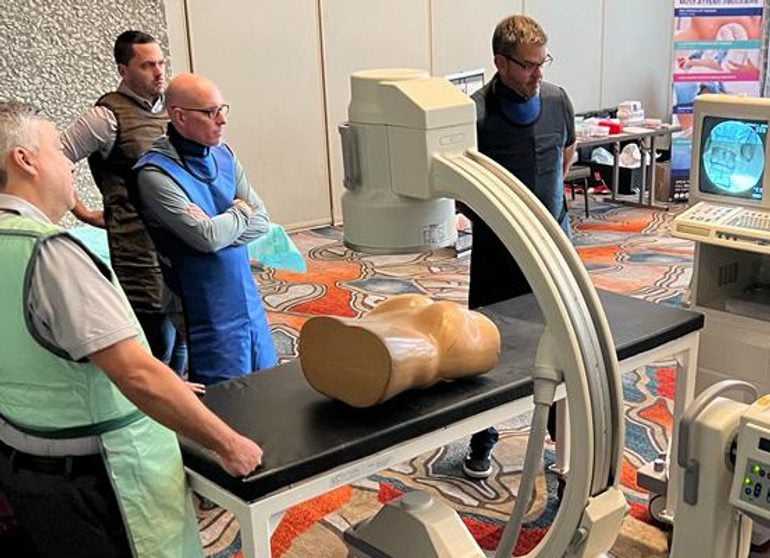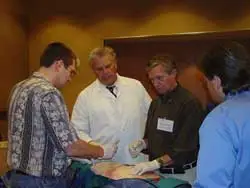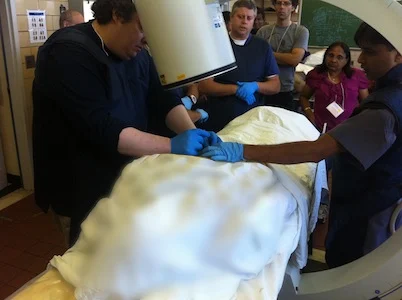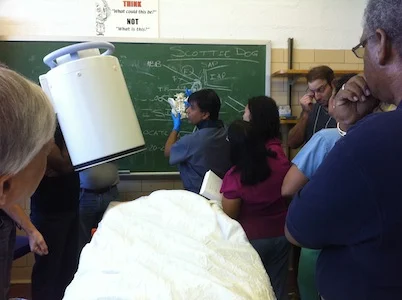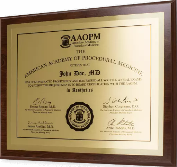DAY 1 - 8:30am–9:00am
Registration
9:00am–10:45am
Speaker Introduction, Lumbosacral Osteology including Scotty Dog, lumbar vertebra, articular, spinous, and traverse processes, landmarks used in Pain Management. Sacrum anatomy, Os Coxa, Sacroiliac Joint, and lumbrosacral region. Injection approaches and correct needle placement for diagnostic and therapeutic pain pathologies.
10:45am-11:00am
Break.
11:00am–12:00pm
Chemical Agents used in Pain Management Injections including facet injections, epidurals, diagnostic injections, anesthesia options, and chemical neurolysis. Review supplies and medications, contraindications, safety profiles, as well as contrasting agents used for imaging including suggested dosing and protocols.
12:00pm–1:00pm
Lunch (on your own)
1:00pm–3:00pm
Fluoroscopy Basics: safety, function, setup, exposure patterns, and general guidelines for image guidance. Ultrasound Basics including advantages, disadvantages, and limitations, transducer selection, advanced technologies, and scanning approaches. Introduction and protocols for Radio Frequency Ablation, new technologies and RF Ablation techniques for lumbar spine, medial branch, and pain indications used for. Introduction to Facet Syndrome including diagnosing various pathologies (indications), treatment protocols, and injection techniques.
3:00pm–3:15pm
Break
3:15pm–5:30pm
Diagnostic Lumbar Facet Joint Injections, pain referrals, medial branch technique, intra-articular technique, patient selection, and irregularities. Destructive Lumbar Facet Joint Injections and epidural training utilizing palpatory method and with image guidance utilizing fluoroscopy with contrast and ultrasound technologies for facet injections.
DAY 2 - 7:30am–8:00am
Registration.
8:00am–10:30am
Review of pain pathologies, indications and treatments options, identification, symptoms, and testing options available for; HNP (herniated nucleus pulposus), spinal stenosis, instability, Spondylolysis, discogenic pain, osteophytes, facet arthritis and other degenerative disk disorders. Proper ICD-10 and CPT Coding, RVU, J-Codes, Global Periods, Patient Charting for various pain procedures as well as valuation of cash basis (non-insurance) pain management services.
10:30am-10:45am
Break
10:45am–12:30pm
Large and small bursa injection training, sacroiliac joint, shoulder injections, AC joint, knee injections and approaches, hip injections, elbow and small bursa. Viscosupplementation therapies for osteoarthritis of the knee and shoulder. Trigger Point Injections, referred pain indications for soft tissues and tendinopathies, Prolotherapy and the use of biologics (i.e. botulinum toxin, platelet rich plasma, exosomes, and umbilical cord blood) for interventional pain procedures.
12:30pm–1:30pm
Lunch (on your own)
1:30pm–3:30pm
Group “A”: Supervised hands-on training using fluoroscopy on anatomical models or cadavers for the following pain management injections; medial branch block, SI joint, Epidural Training and lower lumbar facets (all levels). All protocols, fluoroscopy orientation, safety, and positioning as well as the guidelines for procedures.
1:30pm–3:30pm
Group “B”: Supervised hands-on training utilizing anatomical models for large a medium bursa injections. Review of MSK ultrasound for injections, scanning of “live” patient for various anatomical locations. All protocols, safety considerations, visual approaches for injections, and guidelines for procedure.
3:30pm–3:45pm
Break
3:45pm–5:45pm
Group “B”: Supervised hands-on training using fluoroscopy on anatomical models or cadavers for the following pain management injections; medial branch block, SI joint, Epidural Training and lower lumbar facets (all levels). All protocols, fluoroscopy orientation, safety, and positioning as well as the guidelines for procedures.
3:45pm–5:45pm
Group “A”: Supervised hands-on training utilizing anatomical models for large a medium bursa injections. Review of MSK ultrasound for injections, scanning of “live” patient for various anatomical locations. All protocols, safety considerations, visual approaches for injections, and guidelines for procedure.
DAY 3 - 8:30am–9:00am
Registration.
9:00am–10:45am
Chronic Pain Management Administration, requirements, FDA oversight, compliance, and ethical standards. Review of various pain medications, mechanism of action, patient selection, follow-up, tapering, and side effects (i.e. testosterone). Patient evaluation, psychological review, chronic versus acute pain pathologies, legal concerns, and administrative record keeping. Patient drug contracts, testing, and re-evaluation.
10:45am-11:00am
Break
11:00am–12:30pm
Physical Therapy options for lower lumbar pain management, prescribing for physical therapy and requirements for physical therapy. Demonstration and review of the Cervical Spine, cervical epidurals and cervical facets including needle placement, injection techniques, contrast, pain pathologies, and alternative therapies.
12:30pm–1:30pm
Lunch (on your own)
1:30pm–2:30pm
Questions and Answers, Certification Pathways. Final Interventional Pain Management Certifications.
2:30pm–5:00pm
Supervised Open Lab Session: Supplemental Hands-On anatomical Model or Cadaver injection training under fluoroscopy for all image guided injections. All spinal injection training, trigger point injections, ultrasound guided injections, and specialty injections are demonstrated and available for additional practice by attendees (i.e. thoracic spine, cervical spine).
DISCLAIMER: The following is a summary of the course agenda. The full course agenda will be emailed to you a few days prior to the course. If you have any questions or need additional information, please contact our office.

